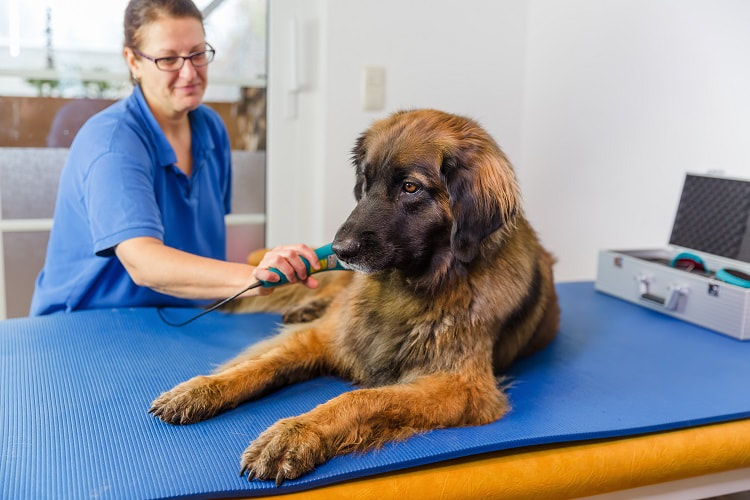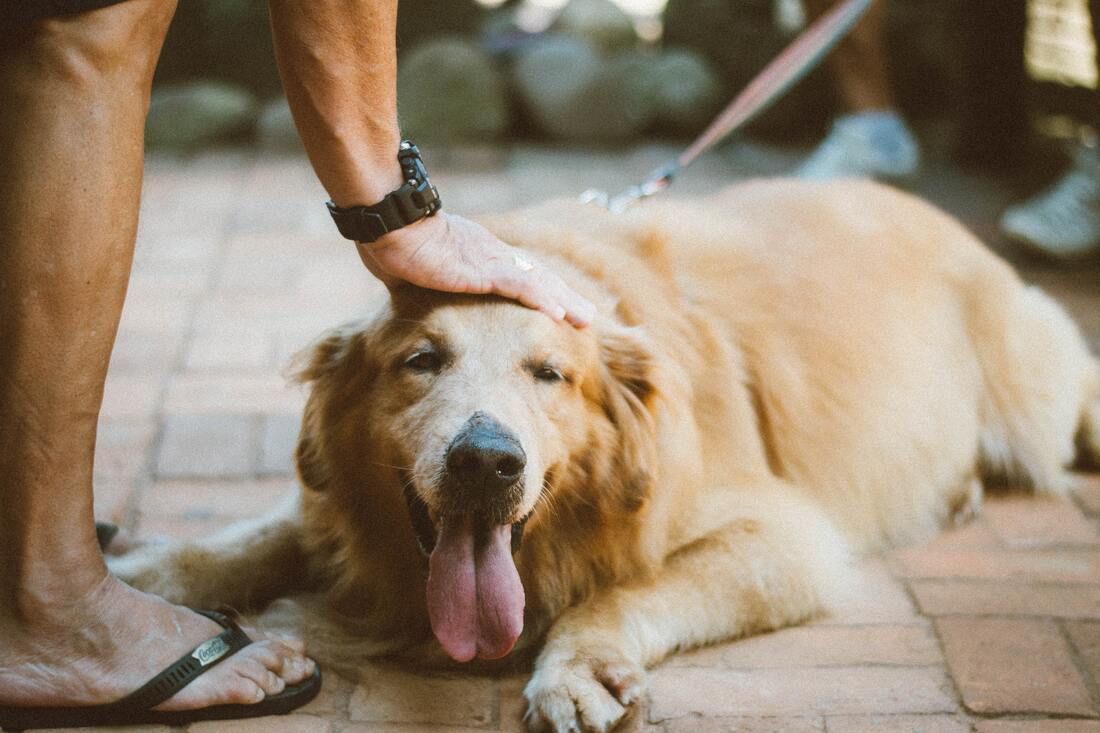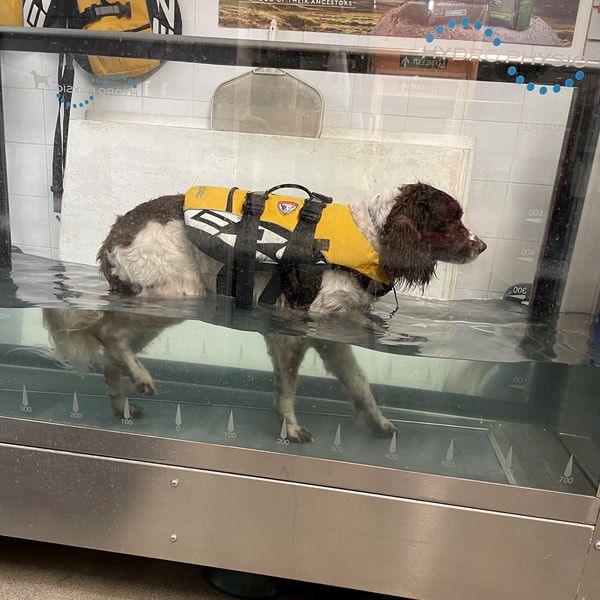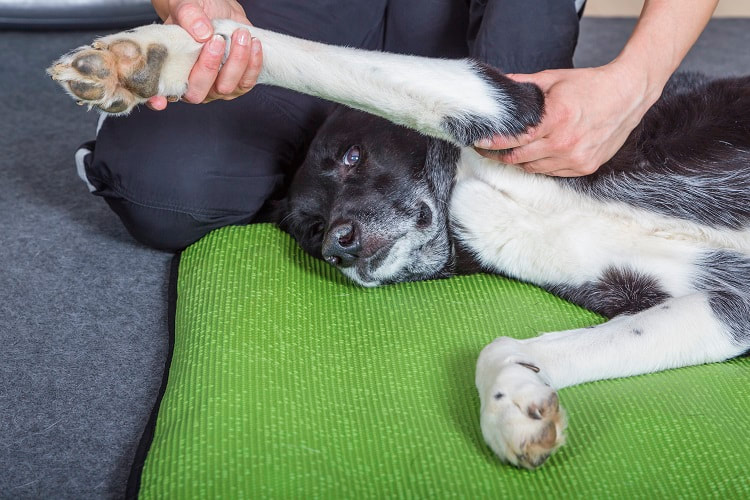|
Osteoarthritis (OA) is the most common form of arthritis found in dogs and is unfortunately extremely common. OA is a chronic joint disease that involves the loss of joint cartilage or new bone formation around the joint (also known as osteophytosis). This condition can be extremely debilitating for the dog and can be a painful condition which in some severe cases leads to limb disfunction. In this article, we give an overview of Canine Osteoarthritis. We explain in more detail what it is, what are the symptoms, and what treatments are available. What is Canine Osteoarthritis?
OA is commonly a secondary condition that is in part caused by another condition such as cranial cruciate ligament disease, hip dysplasia, or elbow dysplasia to name just a few. However, it is not always the case that OA is a result of another condition. In some cases, there is no obvious cause of OA apart from being the result of genetics, age, or other contributing factors such as the weight of the dog, the gender, the breed, the amount of exercise they get as well as their diet. What are the signs and symptoms? As it is such a common condition, dog owners want to understand the signs of symptoms of OA so that they can recognise the condition as early as possible. The main symptoms can include:
How is OA diagnosed? Several factors contribute towards the official diagnosis of Canine OA. It is usually based on a combination of the dog’s history in addition to a physical examination. The physical examination will be an opportunity to look at how the dog’s joints are affected. They will be looked at to see if the dog is showing any signs of pain in response to the joint movement. CT and MRI scans are commonly used as a diagnostic tool. MRIs can provide information about the structure of soft tissue such as the ligaments whilst CT scans are good for assessing any changes to the bone structure of the joints. This information is vital in understanding the problem areas. Xray's can also be recommended to see which joints are affected and to what degree and help rule out any other conditions that it could be that cause similar symptoms. What treatment is available for OA? Whilst there is no cure for Canine osteoarthritis, there are several different approaches available when it comes to treating and coping with the symptoms of OA. This depends on the dog in question as to which method will potentially be most effective. Weight management Controlling with the weight of the dog is a vital part of the treatment. As we discussed earlier in the article, some OA is a direct cause of the dog being overweight. The increased weight is added increased pressure and strain on the joints which can lead to them being in severe pain. Even if their weight wasn’t the cause of the problem, owners need to ensure their dog stays at a healthy weight to try and not make the pain any worse. Ideally, owners should be able to feel their dog’s ribs but not see them and from a bird’s eye view, their dog’s figure should be an hourglass figure. Rehabilitation Several forms of rehabilitation can be used solo or in combination, to improve joint mobility and increase muscle mass. This includes hydrotherapy (swimming or the use of an underwater treadmill), acupuncture, or laser therapy. Activity modification The type of exercise the dog is used to undertaking may need to be amended to stop their condition from worsening. If they are used to doing high-impact activities such as jumping or running, these may have to be limited as they can lead to inflammation of the joints and lead to a lot of pain. Instead of these intense exercises, low impact exercises that are more controlled such as lead walks can help build up muscle strength and stability. Pain medication and supplements NSAIDs- Non-steroidal anti-inflammatory drugs such as meloxicam, ketoprofen, etc are most commonly used when it comes to pain control of OA. Supplements may also be recommended by the veterinarian, depending on the patient. Omega 3 fatty acids or glucosamine sulfate are two common types that are often prescribed and may help alleviate OA pain in the joints. The role of supplements is to improve the function of the joints, reduce inflammation and help slow the progression of the joint damage over time. These medications not only promote healing, they can help increase water retention in the cartilage, which can help provide the joint with more cushioning. Surgery In some extreme cases, surgery may be the best treatment option. The surgery needed can vary from treatment for ligament rupture, or total joint replacement surgery which most commonly involves the hips or elbows for canine patients. Aftercare No matter what method of treatment is used, there will inevitably be a level of aftercare that owners need to be prepared for. OA is a progressive disease, so the main focus of the treatment methods above is to help the dog live comfortably for many years to come. These treatments will not make the condition disappear, but when administered correctly and treatment plans strictly adhered to, the treatments can be extremely effective at slowing down the speed at which OA progresses over time. Whilst canine Osteoarthritis is a common problem in dogs, it is never a pleasant condition to wish on any dog due to its painful and progressive nature. Whilst it is a painful condition, it is one that can be managed. If your dog is showing any of the symptoms described, it is important to consult a veterinarian as soon as possible. They will be able to diagnose the condition and work together with the owner and veterinarian physiotherapists to formulate the best possible care plan.
0 Comments
Dogs are notorious for being reluctant to show pain. This natural instinct can make it incredibly frustrating for dog owners as they may not be aware of how much pain their dog is in or that they are in any pain at all. However, if you study your dog’s body language carefully, over time you will be able to identify subtle signs of pain which will make it easier to manage, treat and hopefully prevent it in the future. In this article, we will discuss how owners can learn more about whether their dog is in pain as well as some canine pain management strategies to hopefully help relieve your dog’s discomfort. How do dogs feel painDue to their survival instinct to try not to show pain, it used to be believed that dogs did not experience pain in the same way humans did. However, in recent years, veterinarians have made huge improvements in the understanding of how dogs feel pain. Studies have shown that although dogs do not show pain as easily, they actually have similar nervous systems to humans and this knowledge has allowed us to implement new canine pain management strategies. Pain is defined as a “highly unpleasant physical sensation caused by illness or injury” and varies significantly depending on the specific injury, condition as well as the individual. As pain is very subjective, it can be difficult to measure, especially as dogs instinctively hide their pain to prevent being seen as weak and vulnerable by predators. Whilst it is challenging to know when a dog is in pain, there are some signs that owners can look for. Common signs of pain in dogs can be:
Spotting the signs is crucial for canine pain management. Whilst these can all be signs of pain, it is important to note that they are not exclusive to dogs experiencing pain. There can be other reasons why they are showing these symptoms. Canine pain management strategies Once it has been established that a dog is in pain, they will need to have a pain management strategy in place. If your dog is undergoing any surgery or dental procedure, feel free to ask what pain management your vet is using as the options are varied.
Medication In general, medication of some form will be given to the dog before, during, and after any surgery to help with pain relief. Many types of drugs can be used to prevent or reduce canine pain and your vet will choose the appropriate drugs based specifically on your dog’s needs and condition. NSAIDs (Non-steroidal anti-inflammatory drugs) This type of drug is used to treat mild to moderate pain and discomfort and work by interfering with the production of inflammatory molecules that trigger swelling and pain. These drugs are powerful and therefore must be used with caution as they can have potential side effects on organs such as the liver, kidneys, and stomach. Opoids Opioids are often used in more severe cases of pain, for example, if a dog is suffering from severe arthritis or cancer. This group of medications includes morphine, codeine, and hydromorphone and are used on selective cases only to try and reduce discomfort and maintain a good quality of life for a dog that suffers from chronic pain. Therapeutic Exercise Depending on the cause of the pain, one pain management strategy could be therapeutic exercises or treatments. For example, dogs with osteoarthritis or similar conditions may benefit greatly from treatments such as laser therapy or hydrotherapy. Establishing a course of treatment is something your veterinary physiotherapist will be able to create as dogs can experience the best benefits when this treatment and exercises are sustained. Acupuncture and massage can also be used to offer pain relief, however, this tends to only provide short-term relief. Weight Management Whilst it can be a challenge for owners to reduce their dog’s weight, studies have shown that lameness can be decreased when dogs lose weight. It is important to note that this method of pain management truly depends on what condition the dog is suffering from. For example, a dog with osteoarthritis may benefit from this method. Untreated pain is something no human or pet should ever have to experience. Whilst it can be challenging to spot if your dog is in pain, once you notice any subtle sign, you must visit your vet. The earlier these signs are caught, the higher the chance your vet will be able to come up with a successful canine pain management strategy to stop the pain or reduce your dog’s pain as much as possible. Canine Elbow dysplasia is a condition that affects many breeds, particularly young medium to large-sized dogs. Unfortunately, treatments remain relatively limited which is a concern for dog owners and breeders alike. Therefore, it is a common question to ask whether Elbow Dysplasia in dogs is genetic. What is Elbow Dysplasia?Elbow dysplasia is an abnormal development of the elbow joint. This results in the early development of osteoarthritis and degenerative changes. The condition is the result of a dog’s elbow joint failing to develop correctly. This prevents its components from working properly together. Types of Elbow DysplasiaThere are three main types of elbow dysplasia conditions that dogs usually suffer from. These are:
Is canine elbow dysplasia genetic?To put it short, yes. The tendency towards elbow dysplasia is usually passed down from a dog’s parents. What dog breeds are most at risk for elbow dysplasia?Elbow dysplasia is most prevalent among certain breeds of dogs., even some of the most popular breeds such as the Labrador Retriever have high rates of the disease. Overall, elbow dysplasia is mostly found in medium and large breeds. A recent study has shown that the following breeds are more susceptible to elbow diseases (including elbow dysplasia). These are:
The gender of the dog can also have an impact. The study showed males have one a half times the risk of developing an elbow disease than females. There are even some breeds such as the Jack Russell terrier and West Highland white terrier that the study showed to actually have reduced risk of elbow disease compared to the average crossbreed dogs. What can breeders and owners do?Whilst the risk of elbow dysplasia cannot be eradicated completely, there are some things that breeders can do to help limit the risk. Often this was done by mating together dogs that are free from the condition. Smart breeding decisions like this make it far less likely that the dog will develop dysplasia. Although the condition is genetic to a degree, there are still environmental factors that can increase the risk of the disease which owners must be aware of. Lack of exercise, poor nutrition and dog obesity can all increase the risk of the dog developing elbow dysplasia at some point during their lifetime. What are the early signs of canine elbow dysplasia?Symptoms can start to show in the dog when they are relatively young at around 5 months. Therefore it is important that tests are done as soon as symptoms start to show. Undertaking a CT scan can help diagnose the condition. The symptoms can vary but include noticing that your dog struggles to bear weight on a certain paw. Or if you notice that a paw is turning outwards more than the others. Other symptoms include walking in a stiff manner, especially after exercise, and a reluctance to exercise in the first place. Whilst there may be a myriad of other reasons why these symptoms have occurred, it is imperative that tests are undertaken in order to rule out elbow dysplasia or catch it as soon as possible. What is the prognosis of elbow dysplasia in dogs?Discomfort can be eased by ensuring the dog maintains a healthy weight and takes regular, short walks on a lead to avoid overexertion and worsening the condition. Try and ensure the dog doesn’t run or jump too much. Also, consider your surroundings. Adapt your home accordingly to ensure your dog remains comfortable and reduce the risk of falls.
In some cases, anti-inflammatories or painkillers can be prescribed and in certain cases. A combination of surgery or physiotherapy may be the best route to explore. We hope we have answered the question is Elbow Dysplasia in dogs genetic. Whilst elbow dysplasia is a painful, long-term condition, the positive news is that it shouldn’t shorten the dog's life. By ensuring the dog’s discomfort is lowered through a healthy lifestyle, the dog can still enjoy a great quality of life. If you are concerned about your dog having elbow dysplasia then ensure you visit a trained veterinary professional for an early diagnosis. When dogs have neurological disorders the signs can start extremely quickly which is scary for both the dogs and their owners. Whilst the symptoms may not necessarily mean it is something to be concerned about, the treatment options available will be more successful if the symptoms are spotted sooner. Therefore, owners must understand what the signs are. With a range of possible diagnoses and treatments, here we explain the most common neurological disorders in dogs. What are canine neurological disorders?Canine neurological disorders are classed as any illness that stems from the dog’s central nervous system. These disorders are common caused by injury, diseases, or other health issues. As they can target the brain, spinal cord, and nerves and can be severe, they need treatment as soon as possible for an accurate diagnosis. What are some of the symptoms?Whilst the symptoms can vary significantly, here are some of the common symptoms that indicate a potential neurological based disorder in dogs:
How to diagnose neurological disorders in dogs?Whilst there is no single way to diagnose, a veterinary may start their medical investigation by seeking out the answers to the following:
What are common neurological disorders in dogs?Vestibular DiseaseThe vestibular system helps maintain balance and coordination of the head and eyes. If there is a problem with this system, dogs can usually show symptoms such as a strange head tilt, nausea, sporadic eye movement, and even difficulty standing. A specific type of vestibular disease can be found in more mature dogs. Commonly known as Old Dog Vestibular Disease. This adversely affects the balance of the dog and can feel like the room is spinning. These symptoms can be scary for an owner to see and some owners confuse them and assume their dog is having a stroke when this may not actually be the case. Depending on the patient and the severity, there are anti-nausea drugs that can be administered to help keep the dog feeling more comfortable. Spinal DiseasesAn issue with the spinal cord is called myelopathy and signs can vary from pain to complete paralysis. From carrying out imaging tests such as MRI or CT scans, veterinarians should be able to localise the pain and get a clearer understanding of what is causing it. One type of spinal disease is Wobbler Syndrome. This disorder is caused by abnormalities in the back and soft tissues of the neck that lead to the compression of the spinal cord. Over time this can lead to the dog showing an unsteady gait. Once the disorder has been diagnosed, it can often be treated via surgery or a combination of surgery and other medical therapies. A common cause of back and neck pain in dogs that can lead to a lack of coordination is Intervertebral Disc Degeneration and Herniation. (IVDD) . The discs usually function to provide cushioning between the bones and spine, so when this starts to degenerate, it hardens and causes compression of the spinal cord which can be extremely painful. SeizuresSeizures can be a terrifying and traumatic thing for the dog and the owners to see. The fact that they are sudden is part of why they are so scary. Seizures are a sign of abnormal electrical activity in the brain for a varying length of time and can be an indication of several issues. Seizures can be caused by metabolic problems such as a deficiency in vitamins like calcium or because the patient has low blood sugar. Carrying out blood tests should be able to identify this. They could also be caused by something a bit more sinister such as a tumour or infection in the brain. CT and MRI scans again should be able to be used to see if this is the case or to rule it out. If none of these are causing the seizures, the dog could be diagnosed with epilepsy. Once the root of seizures has been figured out, the treatment aims to decrease the frequency that they occur. This can often be done with anti-epileptic drugs or a combination of medication and other forms of treatment. Treatments for neurological diseasesThe treatments available depends on the individual dog and its condition. However, popular treatments that can be used on a range of disorders include hydrotherapy, balance exercises, acupuncture, cryotherapy, and laser therapy - all of which can potentially be effective techniques for pain control. There also may be surgical options available. Whilst some of the disorders will be able to be healed or cured, others may not be and will have to be managed instead.
We understand that neurological disorders can be serious and sudden which is a terrifying prospect for owners. However, by having an understanding of what the symptoms are and what signs to look out for, owners will be in the best position possible to seek medical help urgently if any of these symptoms occur. The swiftness of the response will hopefully help the disorder be diagnosed as quickly as possible and a treatment plan put in place that is tailored to the dog. Hydrotherapy has been around for thousands of years due to the healing properties of water. The benefits of hydrotherapy for dogs cannot be understated. Water is used as a form of therapy that aids healing and improves overall health. Whilst humans have been using this method for a long time, using it for animals is comparatively new. Starting with racehorses, they were walked through water to help heal and improve their strength. This then moved onto racing greyhounds and now is regularly used on many forms of smaller animals, including cats and dogs. Here we discuss in more detail what hydrotherapy is as well as the benefits of hydrotherapy for dogs. What is hydrotherapy?The properties of water allow the dog to exercise without having to bear its full weight on the injured area. Doing these exercises can not only improve the circulation of blood to the muscles, but it can also improve overall flexibility and reduce pain and swelling significantly. Hydrotherapy for dogs usually involves walking in water or swimming. A specific treatment plan is structured for each patient, depending on the injury and condition of the dog. Types of Hydrotherapy for dogsUnderwater TreadmillIn many cases, the dog will start off on the underwater treadmill as this more control over the dog’s movements. Therefore, the treatment can be much more targeted. The water level is dependent on the dog and their condition which is why this method of hydrotherapy can be extremely effective, as it can be tailored. The amount of support provided through the water level and treadmill speed to the dog will depend on their condition as well as their progress. WhirlpoolWhirlpool therapy is often used on dogs post-surgery as it can reduce pain substantially. Once the dog has entered the water, a warm jet stream comes on which is essentially massaging the dog and helping ease the pain of their injury. PoolHydrotherapy in the pool is less controlled but is still an effective way to improve mobility and strength. Especially for elbows, chest muscles, and limbs. If the dog is not comfortable in the water, some dogs may prefer the pool as it is more freeing and potentially more fun. However, the treadmill or whirlpool may be more beneficial to them. A pet hydrotherapy specialist will be able to determine whether a treadmill, whirlpool, pool, or a combination will work best for your dog. What conditions can hydrotherapy help?This form of treatment has been proven to help a range of conditions including, but not limited to:
What are the benefits of Hydrotherapy?
Hydrotherapy provides a safe, low-impact form of exercise that can benefit your dog greatly. Not only can it help reduce pain from injuries, but it is also great for improving core strength, weight loss, and building strength.
Whether your dog has orthopaedic, neurological, soft tissue injuries, or some other degenerative medical condition, hydrotherapy could be an important and effective part of their overall health and fitness plan. To find out whether this form of treatment is suitable for your dog and their condition, get in touch with a qualified pet physiotherapist who will be able to advice you on the next steps. Arthritis is a common infliction in dogs that can be debilitating. Although it is mainly older dogs that suffer, chronic pain in younger dogs can also be caused by arthritis. Despite arthritis being extremely commonplace, there is still a lot that that dog owners do not know about the condition. Since it can cause your dog extreme pain, it is important to learn as much as you can about it. Even if your dog has not been diagnosed, it is also vital that you know the signs. In our guide for pet owners, we discuss in more detail what arthritis is, what the symptoms are, what causes it, and what treatments are available.
 Animal physiotherapy is a holistic therapy based on scientific research and usually carried out under veterinary referral. From horses to dogs, farm animals and more, animal physiotherapy has been proven to significantly improve mobility and health. Here we answer the questions "What is animal physiotherapy?" and "will physiotherapy help my pet?" |
AuthorNAVP Archives
June 2024
Categories
All
|
The Association |
Services |
|







 RSS Feed
RSS Feed